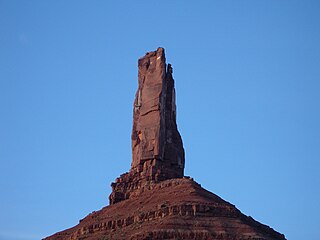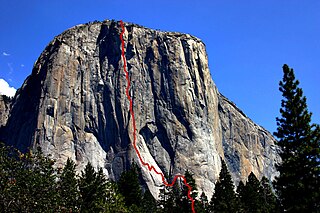Related Research Articles

Half Dome is a quartz monzonite batholith at the eastern end of Yosemite Valley in Yosemite National Park, California. It is a well-known rock formation in the park, named for its distinct shape. One side is a sheer face while the other three sides are smooth and round, making it appear like a dome cut in half. It stands at nearly 8,800 feet above sea level and is composed of quartz monzonite, an igneous rock that solidified several thousand feet within the Earth. At its core are the remains of a magma chamber that cooled slowly and crystallized beneath the Earth's surface. The solidified magma chamber was then exposed and cut in half by erosion, therefore leading to the geographic name Half Dome.

Friedrich Wolfgang Beckey, known as Fred Beckey, was an American rock climber, mountaineer and book author, who in seven decades of climbing achieved hundreds of first ascents of some of the tallest peaks and most important routes throughout Alaska, the Canadian Rockies and the Pacific Northwest. Among the Fifty Classic Climbs of North America, seven were established by Beckey, often climbing with some of the best known climbers of each generation.
Steve Roper is a noted climber and historian of the Sierra Nevada in the United States. He along with Allen Steck are the founding editors of the Sierra Club journal Ascent.

The Regular Northwest Face of Half Dome was the first Grade VI big wall climbing route in the United States. It was first climbed in 1957 by a team consisting of Royal Robbins, Mike Sherrick, and Jerry Gallwas. Its current aid climbing rating is VI 5.9 A1 or 5.12 for the free climbing variation. It is recognized in the historic climbing text Fifty Classic Climbs of North America and considered a classic around the world.
Middle Triple Peak is the second highest peak in the Kichatna Mountains, a subrange of the Alaska Range in Alaska, United States. It is a striking rock tower, with immense, sheer walls on the east and west sides.

Layton Kor was an American rock climber active in the 1960s, whose first ascents and drive for climbing are well known in the climbing world. His routes included many climbs in Eldorado Canyon, near Boulder, Colorado, The Diamond on Longs Peak, towers in the desert southwest, and Yosemite National Park, among other locations. Notable among his first ascents is the Kor-Ingalls Route on Castleton Tower and The Finger of Fate Route up the Fisher Towers' Titan; both routes are recognized in the historic climbing text Fifty Classic Climbs of North America.

Fifty Classic Climbs of North America is a 1979 climbing guidebook and history written by Steve Roper and Allen Steck. It is considered a classic piece of climbing literature, known to many climbers as simply "The Book", and has served as an inspiration for more recent climbing books, such as Mark Kroese's Fifty Favorite Climbs. Though much of the book's contents are now out of date, it is still recognized as a definitive text which goes beyond the traditional guidebook.

The Nose is a big wall climbing route up El Capitan. Once considered impossible to climb, El Capitan is now the standard for big wall climbing. It is recognized in the historic climbing text Fifty Classic Climbs of North America and considered a classic around the world.

The Kor-Ingalls Route is a traditional rock climbing route located on Castleton Tower. Castleton Tower sits in Castle Valley North-East of Moab, Utah. The Route is recognized in the historic climbing text Fifty Classic Climbs of North America and considered a classic around the world.
The Traveler Buttress is a technical rock climbing on Lover's Leap route near Tahoe, California, USA, and is featured in Fifty Classic Climbs of North America.

The Salathé Wall is one of the original big wall climbing routes up El Capitan, a 3,000-foot (900 m) high granite monolith in Yosemite National Park. The Salathé Wall was named by Yvon Chouinard in honor of John Salathé, a pioneer of rock climbing in Yosemite. The route is recognized in the historic climbing text Fifty Classic Climbs of North America and is considered a classic around the world.

The East Face of Mount Whitney is a technical alpine rock climbing route and is featured in Fifty Classic Climbs of North America. Mount Whitney is the highest peak in the contiguous United States.

The Steck-Salathé Route is a big wall traditional climbing route up Sentinel Rock.

The Royal Arches Route is a big wall climbing route in California's Yosemite Valley on the Royal Arches wall. The route is recognized in the historic climbing text Fifty Classic Climbs of North America. The route was first climbed Oct. 1936 by Ken Adam, Morgan Harris, K. Kenneth Davis. The route is moderate in difficulty and is frequently climbed. The first 4 pitches are along a west-facing dihedral. At Pitch 5, the route turns north and ascends the main face along crack systems. Pitch 10 can be free climbed at 5.10b however, most climbers use a fixed rope to pendulum to a long ledge. At the end of Pitch 15, begins the bolted rappel route. It is 18 rappels to the Valley floor. Some climbers prefer to continue to "The Jungle" at the end of Pitch 16. Beyond The Jungle is a 5.4 slab and 4th Class scrambling to the Valley Rim. The descent is usually accomplished by traversing northeast to Washington Column and descending the exposed North Dome Gully.

The North Face of Fairview Dome also known as the Regular Route of Fairview Dome is a technical rock climbing route in Tuolumne Meadows of Yosemite National Park. It is featured in Fifty Classic Climbs of North America.

Charlotte Dome is a granite dome in California's Kings Canyon National Park. It lies to the southeast of Glacier Monument and north of Bubbs Creek. It is most easily accessed from the Onion Valley trailhead to the east. The South Face Route is featured in Fifty Classic Climbs of North America. This climb is a grade III, class 5.7.
Allen Parker Steck was an American mountaineer and rock climber.

Thomas "Tom" M. Frost was an American rock climber known for big wall climbing first ascents in Yosemite Valley. He was also a photographer and climbing equipment manufacturer. Frost was born in Hollywood, California, and died in Oakdale, California.

Charles Marshall Pratt was an American rock climber known for big wall climbing first ascents in Yosemite Valley. He was also a long-time climbing instructor and mountain guide with Exum Mountain Guides in the Grand Tetons.
Chris Jones was a British–American rock climber, photographer, climbing historian, author, and alpinist. He is known for establishing difficult and influential alpine style climbing routes from 1965–1980 in the Andes and the Canadian Rockies. He was the author of Climbing in North America, one of the earliest books on the history of climbing in North America from the 1800s to the 1970s. He was a co-author and contributed photos to the book, Climbing Fitz Roy, 1968 Reflections on the Lost Photos of the Third Ascent which documented a 1968 expedition to Patagonia by Jones, Chouinard, Tompkins, and Dorworth. The photos included in the book were thought to have been lost in a 1996 wildfire that destroyed Jones's California home but copies were later found by Dorworth.
References
- ↑ McNamara, Chris (March 2004). High Sierra Climbing (1st ed.). Supertopo LLC. ISBN 0-9672391-8-4.
- ↑ Croft, Peter (2002). The Good, The Great, and the Awesome. Maximum Press. ISBN 0-9676116-4-4.
- ↑ Roper, Steve; Steck, Allen (1979). Fifty Classic Climbs of North America . San Francisco: Sierra Club Books. pp. 295–299. ISBN 0-87156-292-8.
- ↑ Jones, Christopher A.G. (1971). "Charlotte Dome, East Face". American Alpine Journal . American Alpine Club: 351. Retrieved 2025-01-12.